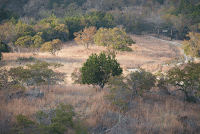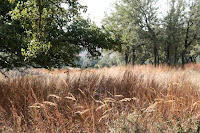Hello friends (new and old) and Welcome to the Bamberger Ranch (Preserve) Journal (blog).
I plan to post frequent blogs (I'll try for once a week) with narratives and pictures of interesting things happening here, primarily in the natural world, but also about people and events.
A Little Background About Bamberger Ranch Preserve (BRP)
The BRP is a 5500 acre ranch that is in a 501-C-3, non-profit foundation with a board of directors, educational staff, and a ranch operations manager. A small portion of the ranch is not yet in the foundation, so that it's founders, J David Bamberger and his wife, (me) Margaret can live here for now. When we are both gone the house and its surroundings will be added to the Preserve.
At the ranch we have domestic animals (cows & goats), educational programs, and Stewardship workshops (see our website for more about these: www.bambergerranch.org). We also have a herd of Scimitar Horned Oryx which are no longer found in the wild in its homeland of Africa and is being protected and managed as part of an SSP (Species Survival Program). We built a man made bat cave, called a Chiroptorium, which is home to 120,000 Mexican free-tailed bats from March to October. Several endangered birds live and nest here also, the Golden-cheeked Warbler, and the Black-capped Vireo. A total of 202 species of birds have been documented as being seen here.
Recently
The grasses are more beautiful then I have ever seen them before. During the abundant spring and early summer rains they grew to unusually large sizes, and the individual bunch grasses such as the bluestems and the muhlys increased in width. Then as fall arrived they turned fabulous colors. The bluestems turn shades of rusty red, yellow indiangrass a fine deep gold, and some others a straw yellow. The combination of height, thickness and color have made the last month stunning.
Today I noticed that in the last four days the colors of the trees have changed dramatically and the reds and oranges have developed and are bright and beautiful.
This is the first time I've tried to write a blog. I look forward to learning more about how to get pictures to go where I want them, and expect that after a while I'll find the process much easier than I do now. So until next week, goodbye -and don't forget to take time to enjoy the natural world.
Photographs: 1- Madrone Lake in late summer this year. Note that Cory our dog is engaged in his favorite summer activity, fishing. He watches the fish in the water, and jumps when he thinks he can catch one - so far he hasn't succeeded. 2- Looking down from a hill-top to a scene below to a field and the woods in the background. (Taken several weeks ago.) 3- Grasses, including yellow indian-grass and little bluestem, with live oaks. (Taken last Tuesday).



2 comments:
Welcome, Margaret. I hope your blog finds the robust audience that it deserves.
By the way, one thing I've been wondering for a while, and this might make a good subject for a future blog post is this: I remember tagging along on a ranch tour that included a visit to the Scimitar-horned Oryx. David stated something to the effect that the genetic diversity of the existing stock would only be sufficient to keep the species genetically viable for something like 100 years. After that point he said, the species would be doomed and there'd be no point in continuing the species survival program for it. Which makes sense - at some point in-breeding must set-in, and start to undermine the species.
What I wonder about, however, is, if their native African habitat became viable again tomorrow, and the species could be re-introduced, what would be different? Why wouldn't those same individuals breeding in the wild also exhaust their genetic diversity, become inbred, and the species fail?
On a related note, is the loss of genetic diversity in the species necessarily a death-blow? It's certainly an extremely serious problem, but the success of starlings (introduced to North America) and house finches (introduced to eastern North America), both from small initial populations, suggests that a lack of genetic diversity isn't necessarily fatal to a species. Of course, those birds breed faster than large mammals like the Oryx, so they're better able to take advantage of random mutations as a means to create new genetic diversity (the large populations, I assume, making the mostly disadvantageous mutations less of a problem than the rare advantageous mutations are a virtue).
Margaret:
Pleasant text; informative
Good pictures
Looking forward to your posts of the coming weeks.
Congradulations to You and Mr. Bamberger for your dedication and leadership in preserving nature for generations to come.
Your willingness to share your efforts through education with others is greatly appreciated throughout the World. Thank you.
Continued success,
BJS, master naturalist
Post a Comment